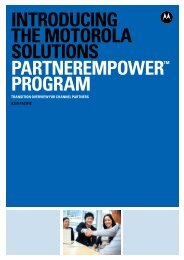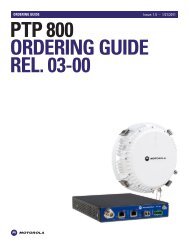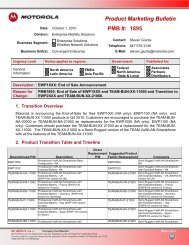Supplement to the Canopy System Release 8 User Guide PMP 400
Supplement to the Canopy System Release 8 User Guide PMP 400
Supplement to the Canopy System Release 8 User Guide PMP 400
Create successful ePaper yourself
Turn your PDF publications into a flip-book with our unique Google optimized e-Paper software.
<strong>PMP</strong> <strong>400</strong> and PTP 200 Series<strong>Canopy</strong> <strong>User</strong> <strong>Guide</strong> <strong>Supplement</strong>4 ConfiguringMost <strong>Canopy</strong> Series <strong>400</strong> configuration items are identical or very similar <strong>to</strong> configuration items instandard FSK <strong>Canopy</strong> modules. This section discusses those that are new or changed and alsoremarks on some that remain unchanged.4.1 LINK OPERATION – 1X/2X/3X<strong>PMP</strong> <strong>400</strong> and PTP 200 Series products offer three levels or speeds of operation – 1X, 2X, and 3X- instead of <strong>the</strong> two levels offered by standard <strong>Canopy</strong>. 3X supports a typical maximum aggregate(sum of up and down) throughput of up <strong>to</strong> 21 Mbps.. If received power is less due <strong>to</strong> distancebetween <strong>the</strong> AP/BHM and <strong>the</strong> SM/BHS or due <strong>to</strong> obstructions, or interference affects <strong>the</strong> RFenvironment, <strong>the</strong> <strong>Canopy</strong> system will au<strong>to</strong>matically and dynamically adjust links <strong>to</strong> <strong>the</strong> bes<strong>to</strong>peration level. Distance, rates and o<strong>the</strong>r information associated with <strong>the</strong> operation levels areshown in Table 2 on page 12.Similar <strong>to</strong> standard <strong>Canopy</strong>, <strong>the</strong> system chooses its operation rate dynamically, based on<strong>Canopy</strong>’s internal ARQ (Au<strong>to</strong>matic Repeat reQuest) error control method. With ARQ, every dataslot of every frame sent over <strong>the</strong> air (expect downlink broadcast) is expected <strong>to</strong> be acknowledgedby <strong>the</strong> receiver, and if acknowledgement is not received, <strong>the</strong> data is resent. The sending unitmoni<strong>to</strong>rs <strong>the</strong>se resends, and adjusts <strong>the</strong> operation rate accordingly. A normal system may havelinks that move from 3X <strong>to</strong> 2X and back (or 1X) as <strong>the</strong> RF environment changes, or links.Fur<strong>the</strong>rmore, <strong>the</strong> links operate independently, and it is normal, for example, for <strong>the</strong> downlink <strong>to</strong>run at 3X while <strong>the</strong> uplink RF environment only supports 2X.The default is for both AP/BHM and SM/BHS <strong>to</strong> be enabled for 3X operation. An opera<strong>to</strong>r may“lock down” a link <strong>to</strong> 2X and 1X operation, or <strong>to</strong> only 1 X operation, using <strong>the</strong> Dynamic Rate Adaptparameter on <strong>the</strong> SM’s “Configuration => General” page as shown in Figure 3 on page 15 . Thisparameter locks down both uplink and downlink operation. An opera<strong>to</strong>r may lock down an entiresec<strong>to</strong>r <strong>to</strong> 2X and 1X operation, or <strong>to</strong> only 1 X operation, using <strong>the</strong> Dynamic Rate Adapt parameteron <strong>the</strong> AP’s “Configuration => General” page. This parameter locks down uplink and downlink ofall links in <strong>the</strong> sec<strong>to</strong>r, and overrides any SM 1X/2X/3X settings. That is, if an individual link is setfor 3X operation at <strong>the</strong> SM, but <strong>the</strong> sec<strong>to</strong>r is set for 1X operation at <strong>the</strong> AP, that link (and all linksin <strong>the</strong> sec<strong>to</strong>r) will be locked down <strong>to</strong> 1X operation.Issue 3, January 2009 Page 17 of 45
















